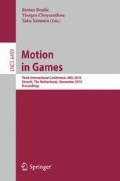Abstract
Physical realism plays an important role in the way character animations are being perceived. We present a method for evaluating the physical realism of character animations, by using musculoskeletal model simulation resulting from biomechanics research. We describe how such models can be used without the presence of external force measurements. We define two quality measures that describe principally different aspects of physical realism. The first quality measure reflects to what extent the animation obeys the Newton-Euler laws of motion. The second quality measure reflects the realism of the amount of muscle force a human would require to perform the animation. Both quality measures allow for highly detailed evaluation of the physical realism of character animations.
Access this chapter
Tax calculation will be finalised at checkout
Purchases are for personal use only
Preview
Unable to display preview. Download preview PDF.
References
van Welbergen, H., van Basten, B.J.H., Egges, A., Ruttkay, Z., Overmars, M.H.: Real Time Animation of Virtual Humans: A Trade-off Between Naturalness and Control. Eurographics - State of the Art Reports, 45–72 (2009)
O’Sullivan, C., Dingliana, J., Giang, T., Kaiser, M.K.: Evaluating the visual fidelity of physically based animations. ACM TOG 22(3), 527–536 (2003)
Reitsma, P.S.A., Pollard, N.S.: Perceptual metrics for character animation: sensitivity to errors in ballistic motion. ACM TOG 22(3), 537–542 (2003)
Runeson, S., Frykholm, G.: Visual perception of lifted weight. Journal of exp. psychology: Human Perception and Performance 7(4), 733–740 (1981)
Michaels, C.F., De Vries, M.M.: Higher Order and Lower Order Variables in the Visual Perception of Relative Pulling Force. Journal of Experimental Psychology: Human Perception and Performance 24(2), 20 (1998)
Safonova, A., Hodgins, J.K.: Analyzing the physical correctness of interpolated human motion. In: Proc. of the 2005 ACM SIGGRAPH/Eurographics Symposium on Computer Animation, pp. 171–180 (2005)
Ikemoto, L., Arikan, O., Forsyth, D.: Quick transitions with cached multi-way blends. In: Proc. of the 2007 Symp. on Interactive 3D Graphics and Games, pp. 145–151. ACM, New York (2007)
Ren, L., Patrick, A., Efros, A.A., Hodgins, J.K.: A data-driven approach to quantifying natural human motion. ACM TOG 24(3), 1090–1097 (2005)
van Basten, B.J.H., Egges, A.: Evaluating distance metrics for animation blending. In: Proc. of the 4th Int. Conf. on Foundations of Digital Games, pp. 199–206. ACM, New York (2009)
Shin, H.J., Kovar, L., Gleicher, M.: Physical touch-up of human motions. In: Proc. of the 11th Pacific Conf. on Comp. Graphics and Appl., pp. 194–203 (2003)
Ko, H., Badler, N.I.: Animating human locomotion with inverse dynamics. In: IEEE Computer Graphics and Applications, 50–59 (1996)
Erdemir, A., McLean, S., Herzog, W., van den Bogert, A.J.: Model-based estimation of muscle forces exerted during movements. Clinical Biomechanics 22(2), 131–154 (2007)
Veeger, H.E.J., Van Der Helm, F.C.T.: Shoulder function: the perfect compromise between mobility and stability. Journal of Biomechanics 40(10), 2119–2129 (2007)
Rasmussen, J., Damsgaard, M., Surma, E., Christensen, S.T., de Zee, M., Vondrak, V.: Anybody-a software system for ergonomic optimization. In: Fifth World Congress on Structural and Multidisciplinary Optimization (2003)
van Den Bogert, A.J., Geijtenbeek, T., Even-Zohar, O.: Real-time estimation of muscle forces from inverse dynamics. health.uottawa.ca, 5–6 (2007)
Delp, S.L., Anderson, F.C., Arnold, A.S., Loan, P., Habib, A., John, C.T., Guendelman, E., Thelen, D.G.: OpenSim: open-source software to create and analyze dynamic simulations of movement. IEEE Trans. on Bio-Medical Eng. 54(11), 1940–1950 (2007)
van Der Helm, F.C.T.: A finite element musculoskeletal model of the shoulder mechanism. Journal of Biomechanics 27(5), 551–553 (1994)
Kane, T.R., Levinson, D.A.: Dynamics online: theory and implementation with AUTOLEV. Online Dynamics, Inc. (1996)
Xia, Y., Feng, G.: An improved neural network for convex quadratic optimization with application to real-time beamforming. Neurocomputing 64, 359–374 (2005)
Author information
Authors and Affiliations
Editor information
Editors and Affiliations
Rights and permissions
Copyright information
© 2010 Springer-Verlag Berlin Heidelberg
About this paper
Cite this paper
Geijtenbeek, T., van den Bogert, A.J., van Basten, B.J.H., Egges, A. (2010). Evaluating the Physical Realism of Character Animations Using Musculoskeletal Models. In: Boulic, R., Chrysanthou, Y., Komura, T. (eds) Motion in Games. MIG 2010. Lecture Notes in Computer Science, vol 6459. Springer, Berlin, Heidelberg. https://doi.org/10.1007/978-3-642-16958-8_2
Download citation
DOI: https://doi.org/10.1007/978-3-642-16958-8_2
Publisher Name: Springer, Berlin, Heidelberg
Print ISBN: 978-3-642-16957-1
Online ISBN: 978-3-642-16958-8
eBook Packages: Computer ScienceComputer Science (R0)

